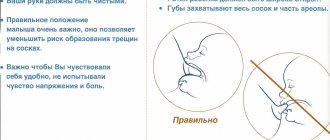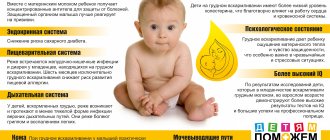As the baby passes through the birth canal, complex hormonal changes trigger a natural and important process—lactation.
Preparation for it occurs throughout pregnancy. Changes are felt in the breasts: they increase in size, harden, sometimes tug, even the size and color of the areola may change. The fatty tissue of the breast is gradually replaced by glandular tissue and the woman’s body prepares for successful breastfeeding.
From mid-pregnancy and the first days after birth, the breasts produce colostrum. From 2-6 days the period of transitional milk begins. Typically, by day 14 of breastfeeding, mature milk is produced.
What is colostrum
Colostrum is the breastfeeding your baby will receive in the first days of life. In fact, it is very thick milk, secreted in small quantities. It is also called unripe milk.
Colostrum is unique in its composition and fully meets the needs of the newborn. It is rich in immunoglobulins, proteins and leukocytes, vitamins, amino acids, enzymes, has laxative components, as well as growth factors.
All this provides natural immunization of the child’s body, protection against infections, allergies and intolerances, and promotes proper maturation of the intestines and all systems.
When does colostrum appear?
Many women already in the second or third trimester notice wet spots on clothes in the chest area, especially after sleep, a warm shower, sexual intercourse or massage. Don't be scared and run to the doctor.
Your breasts “test” all their systems for further feeding of the baby. If you do not have any discharge from your breasts during pregnancy, you also should not worry, try to express and assume that you will not produce milk. You have mammary glands, which means that by the middle of pregnancy you definitely already have colostrum.
Myths about colostrum
It is a very common opinion that breastfeeding is not given to all women, although by nature it is inherent in each of us. So why do many expectant mothers think that breastfeeding with their baby may be difficult?
The answer lies in a large number of myths that have appeared since the beginning of the 20th century, when medicine, industrialization and the role of women in society moved to a new level.
- The appearance of colostrum is a sign that labor is approaching; This is wrong. As previously written, colostrum can be released at any stage of pregnancy and does not provide any information about the approach of labor.
- During pregnancy, you need to express colostrum so that there is more milk later; No, you don’t need to express anything, this does not affect the level of lactation in the future, but it can easily lead to uterine tone and the threat of miscarriage.
- If colostrum is not released during pregnancy, it means there will be no milk and the baby will need supplemental feeding; This has already been written above, but I will repeat it. The absence of colostrum during pregnancy does not indicate possible future difficulties with lactation. Just because you don't see it doesn't mean it's not there.
- Colostrum is harmful to the baby and until the milk comes in you need to feed the baby with formula; The composition of colostrum is so amazing and ideally balanced for a newborn, it protects his immunity, prevents the occurrence of allergies in the future, helps to launch all the systems of the child’s body, that depriving the baby of these precious drops is very unjustified and unsafe.
- Colostrum is very thick and the baby needs additional water; Don't worry, nature has thought of everything here too. The baby's kidneys are not immediately ready to process fluid. That is why nature intended to feed the baby thick colostrum for the first days, and not liquid milk. The baby is born with some fluid reserves in the body to prevent dehydration during the period of feeding with colostrum. By supplementing the child with food and giving him a formula that contains a large amount of water, the child’s kidneys and body are very stressed.
- Colostrum is a strange color (very yellow or, on the contrary, completely white), so you cannot feed your baby with it; Whatever color your colostrum is, it is exactly what it should be, according to your baby's needs. It ranges from transparent white to almost orange and all these are normal variations and are not a cause for concern.
- Colostrum is not enough for the baby to eat; Again, if this were so, humanity would hardly have survived to this day, dying of hunger immediately after birth. A child is not born “empty”.
The baby's entire digestive system is filled with amniotic fluid and meconium - thick original feces formed as a result of the body's processing of epithelium during the formation of internal organs. Before you start receiving a large amount of food, the baby’s body needs to cleanse itself.
Colostrum contains laxatives that help pass meconium. The volume of a newborn's stomach is the size of a cherry, so a few drops of colostrum with frequent breastfeeding is quite enough for a child in the first days of life.
Pain when breastfeeding
Today no one doubts the benefits of breastfeeding.
And expectant mothers, having read a bunch of specialized literature during pregnancy, are very determined to feed their baby with their own milk. But a happy event finally happened: the baby was born. Some time passes, and suddenly the young mother refuses breastfeeding with the same determination. Why? What's happened? Turns out it hurts!
Work calluses
So, when a newborn baby is put to his mother’s breast for the first time, new sensations arise not only for him, but also for his mother. This is especially true for first-born children. But even if a woman has already had experience of motherhood and breastfeeding, her breasts have already managed to “forget” how a tiny tongue and strong gums work. The skin on and around the nipple is very thin and delicate, so the mother is guaranteed quite strong sensations.
The baby instinctively “polishes” the mother’s nipple, and gradually the skin becomes harder and less vulnerable, and a kind of callus is formed. If you've ever learned to play the guitar, you probably remember how each string initially leaves an imprint on the soft pads of your fingers. Then the traces of the guitar strings simply “burn”, and finally the skin becomes rougher, and protective calluses allow you to play the guitar almost painlessly.
Something similar happens during breastfeeding. In the first days after childbirth, the skin may crack slightly, turn white, and white crusts may appear on it. This is how “labor calluses” are formed; this process can take from a couple of days to a couple of weeks.
Pain may occur when the nipple is latched. But as soon as the baby begins to actively suck, the painful sensations go away. Such pain (and sometimes not even pain, but just a strong sensation) occurs under the influence of hormones and does not require special therapeutic measures.
Source
When does transitional milk appear?
When some time passes after birth, usually at least a day later, colostrum begins to become more liquid and arrive in greater volume, the breasts increase in size, and the mother begins to feel hot flushes and fullness in the breasts.
The baby begins to feed more often and the duration of one feeding increases. All this suggests that the process of transition from colostrum to mature milk has begun, which will last until approximately 2 weeks after birth. At this time, the child's kidneys begin to fully function and can now process fluid.
The amount of milk a newborn drinks per feeding
As the milk comes in, the baby's stomach also grows. If on the first day its volume was the size of a cherry, no more than 7 ml, then on the third day it increases to the size of a walnut and holds about 25 ml. And, after another 2-4 days, by the age of a week, its volume becomes comparable to an apricot - 55 ml.
Therefore, feeding a child with formula and supplementing him with water from the first days of life entails many consequences, including a lack of milk production in the mother. After all, nature knows how much a baby eats at a time in a certain period, and having stretched the stomach with unnecessary liquids, the child will constantly feel hungry.
If, for medical reasons, supplementary feeding is justifiably required, it should be given, but from non-sucking objects, so as not to spoil the baby’s latch on to the breast in the future. If you have problems with lactation after supplementary feeding, contact a lactation consultant on the hotline or call at home.
Feeding a newborn with breast milk: positions and difficulties of breastfeeding
Often, a young mother does not yet know all the intricacies of feeding a baby, so the question of how to properly feed a newborn with breast milk is the most important for her.
Breast milk is a natural food that provides the baby with good digestion, stimulates mental development, can protect the baby from many diseases, and also promotes the formation of immunity.
Features of GW
Put in a little effort and time, understand the basic laws of breastfeeding, and then you will watch with a smile as your baby gains weight, grows and develops.
Let's agree right away: immediately before feeding, there is no need to carry out hygiene procedures, which include rinsing the entire breast with cool water, with or without soap. I also don’t wash the nipple.
Important: The protective glands of Mangomery are located on the areola. They produce a protective secretion that prevents infection of the breast, protects it from drying out and cracked nipples.
Application rules
The preparatory stage has already been completed, and now you need to figure out how to properly attach a newborn baby when feeding.
The first thing to do is get comfortable. Feeding a newborn in the first weeks after birth is a long process. The baby can spend from 10 to 60 minutes at the breast, perfectly combining feeding and sleep.
Now let's start figuring out how to properly attach a newborn to the breast. It is important to understand that the process of feeding and latching the nipple is very important. Therefore, to feed breasts, you need to perform the following steps:
Important: Improper latching can lead to the baby swallowing air, as well as damage to the integrity of the nipple and the development of cracks.
With the correct grip, the mouth
Source
What is mature milk
Around two weeks of age, transitional milk becomes fully mature. At this point, the baby's digestive system is able to absorb and digest liquid mother's milk.
It will be best if you organize breastfeeding for an unlimited duration and number of feedings, then you will not have to worry about whether the baby has enough food, drink and all the components necessary for good growth and development.
Composition of mother's milk
Thanks to numerous studies in the field of breastfeeding conducted over the past decades, science knows about 500 components of human breast milk. The meaning of some of them has not yet been studied.
For comparison, the best adapted milk formulas contain 2 times less components, most of which are obtained synthetically.
At the moment, it is impossible to reproduce human milk in any laboratory in the world. It contains hormones, growth factors, components that protect the child’s body, strengthen the immune system, influence the development of all systems and prevent many diseases and developmental delays.
Water
Approximately 87% of breast milk consists of water, which justifies the absence of the need to supplement the child's first 6 months of life before introducing complementary foods.
It is worth noting that when breastfeeding your baby, you can always be one hundred percent sure that the water in mother’s milk, unlike that used in adapted milk formula, is absolutely clean and does not contain harmful bacteria and substances .
Lactose
Carbohydrates in breast milk are present in the form of lactose, which makes up approximately 7% in a ratio of 5.6-8.3 g/100 ml of breast milk. It also contains a small amount of other oligosaccharides, such as fructose, galactose, etc.
It is this component of milk that almost half provides the baby’s body with the energy it needs, participates in the development of the nervous system, the absorption of calcium and iron, as well as in the suppression of pathogenic bacteria, parasites and fungi in the child’s intestines.
Fats
About 4% of breast milk is fat. They are necessary for normal development of the brain and retina. Fats are also necessary for a child’s weight gain and growth, are involved in digestion and intestinal development, and are needed for the proper functioning of the immune system.
Cholesterol contained in milk is involved in vitamin synthesis and the structure of many body tissues. Lecithin synthesizes protein and prevents obesity.
Squirrels
Proteins make up about 1% of breast milk and are easily absorbed by the baby's body. This is an irreplaceable source of all amino acids necessary for babies. Breast milk proteins are the building blocks for the growth of a child’s body. Some of them help strengthen the immune system.
Lactoferrin and lysozyme suppress pathogenic microorganisms.
Immunoglobulins prevent viruses and bacteria from entering the child’s body.
Alpha-lactalbumin has antibacterial properties and can destroy cancer cells.
Additional micronutrients in breast milk
Human milk contains about 1% of the composition various minerals, vitamins and microelements necessary for the proper development and growth of the child’s body from birth. Therefore, breastfed children do not need additional sources of vitamins and early complementary feeding until six months.
Changes in the composition of breast milk
With mother's milk, newborns receive truly natural substances, in contrast to synthetic ones in adapted milk formulas. The amount of beneficial microelements, minerals and vitamins in breast milk can be regulated by healthy nutrition for the nursing mother.
Depending on the age, health status of the baby and his mother, and even during one feeding, the composition of the milk changes.
Change in milk per feeding: foremilk and hindmilk
A breastfeeding mother produces milk all the time. If the child applies it frequently, it is produced faster and more. In the first months before lactation begins, milk tends to accumulate in the breasts, and you can feel this by its fullness and heaviness.
After lactation begins, when the breasts become softer and lighter, milk comes in response to the baby’s sucking, but even in this case it is always in the ducts. If there was a long gap between feedings, say 3 hours, then the milk, like other multicomponent liquids, is divided into fractions - liquid milk with a high content of lactose and fat-soluble vitamins and cream containing fats and fat-soluble vitamins.
The cream settles on the walls of the ducts and during the next feeding the baby will first receive liquid foremilk. As you suck, the milk will move through the ducts, washing away the fatty cream from their walls and by the end of feeding, the fat content of the milk will increase significantly.
When feeding a baby on demand, as a rule, the milk does not have time to separate and there is almost no difference at the beginning and end of feeding.
Composition of breast milk during illness
In the event of a child’s illness, the mother’s body reads information from the child’s body and begins to produce antibodies to the source of the disease. Having received them with mother's milk, they enter the baby's blood and begin to actively fight the infectious agent. If a nursing mother gets sick, the same principle applies. Her body fights the disease, antibodies appear in the milk and, entering the child’s blood, they prevent infection.
Changes in the composition of breast milk depending on the age of the child
A child is born with a supply of antibodies received from the mother in utero. In the first weeks, the amount of antibodies and immunoglobulins in milk is quite high, but then it begins to decrease to allow the child’s body to learn to produce them on its own.
From about six months, their quantity in milk increases again, as the child begins to eat complementary foods and has more active contact with the outside world, being exposed to the danger of contracting viral and bacterial infections.
During so-called growth spurts, when the energy expenditure of the child’s body increases sharply, the fat content of the milk increases, due to which, with a slight increase in its quantity, the energy obtained from it increases and meets the child’s needs.
Why do my breasts hurt when feeding my baby? Reasons and what to do?
From the moment of birth, a close relationship is established between mother and baby. It becomes even stronger when the mother breastfeeds the baby. However, it happens that in these wonderful moments the young mother feels discomfort and even pain. Why do my breasts hurt when feeding my baby? There may be several reasons for this.
Painful sensations during feeding are caused by the natural adaptation of the mammary glands to the process of lactation. But there may be more serious violations that require appropriate action.
Causes of chest pain during feeding
During pregnancy, a woman's breasts prepare to nourish her newborn. The mammary glands swell, the nipples become darker, and colostrum may be released. With the birth of a child, the restructuring of the body occurs even more intensely. Now the main role is played by prolactin - the “motherhood hormone” and oxytocin - the “love hormone”. Under the influence of these hormones, milk is produced and secreted, replacing colostrum. During this period, many mothers note unpleasant and even painful sensations in the chest. They are associated with the following factors:
Fast flow of milk. Many mothers describe it as “fullness” or “tingling” in the breasts. Some may even feel pain;
Getting used to the tender skin of the nipples. It manifests itself in painful sensations when the baby grasps the nipple and the formation of small cracks on it;
Flushes of milk. The formation of lactation occurs within 3 months from the date of birth of the baby, so “flushes” and “leakage” of milk can persist throughout this entire time. During the flow of milk, pain is felt in the chest, nipple area and lower abdomen. Over time, the young mother develops a reflex when milk comes in at the right time.
Source










